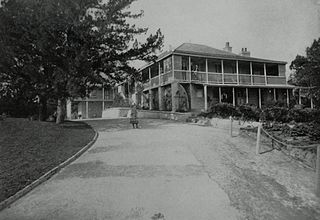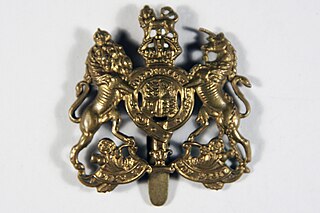 W
WWhile Bermuda technically remains the responsibility of the government of the United Kingdom, rather than of the local Bermudian Government, the island still maintains a militia for the purpose of defence.
 W
WAdmiralty House in Bermuda was the official residence and offices for the senior officer of the Royal Navy in the British Overseas Territory of Bermuda, originally the Commander-in-Chief of the North America and West Indies Station.
 W
WThe Bermuda Cadet Corps was a youth organisation in the British Overseas Territory of Bermuda, sponsored originally by the War Office and the British Army. Modelled on the Cadet Corps in England, now organised as the Army Cadet Force and the Combined Cadet Force, it was organised separately under Acts of the Parliament of Bermuda. It wasn’t one of three Cadet Corps that historically operated in the British territory, with the others being the Bermuda Sea Cadet Corps and the Air Training Corps, of which only the Bermuda Sea Cadet Corps remains. After more than a century of existence, the Bermuda Cadet Corps was disbanded in 2013 and replaced by the resurrected Junior Leaders programme of the Royal Bermuda Regiment.
 W
WThe Bermuda Garrison was the military establishment maintained on the British Overseas Territory of Bermuda by the regular British Army, and its local militia and voluntary reserves from 1701 to 1957. The garrison evolved from an independent company, to a company of Royal Garrison Battalion during the American War of Independence, and a steadily growing and diversifying force of artillery and infantry with various supporting corps from the French Revolution onwards. During the American War of Independence, the garrison in Bermuda fell under the military Commander-in-Chief of North America. Subsequently, it was part of the Nova Scotia Command until 1868, and was an independent Bermuda Command from then 'til its closure in 1957.
 W
WBetween 1612 and 1687, Bermuda had a series of militias under the Virginia Company, the Somers Isles Company, and the British Crown. In 1687, the first Militia Act was enacted.
 W
WThe Bermuda Militia Artillery was a unit of part-time soldiers organised in 1895 as a reserve for the Royal Garrison Artillery detachment of the Regular Army garrison in Bermuda. The unit was embodied during both world wars, fulfilling its role within the garrison, and also sending contingents overseas to more active theatres of the wars.
 W
WThe Bermuda Militia Infantry was raised in 1939 as a part-time reserve of the British Army's Bermuda Garrison.
 W
WBermuda has organised several different forms of militia between the 1612 and 1815. The roles of the militias included defence of the colony in complement with the activities of the British Army and Royal Navy.
 W
WThe Bermuda Sea Cadet Corps was created as a registered charity under the Bermuda Sea Cadet Association Act, 1968. The first unit had actually been created two years earlier.
 W
WThe Bermuda Volunteer Engineers was a part-time unit created between the two world wars to replace the Regular Royal Engineers detachment, which was withdrawn from the Bermuda Garrison in 1928.
 W
WThe Bermuda Volunteer Rifle Corps (BVRC) was created in 1894 as an all-white, racially segregated reserve for the Regular Army infantry component of the Bermuda Garrison. Renamed the Bermuda Rifles in 1951, it was amalgamated into the Bermuda Regiment in 1965.
 W
WRNAS Bermuda was a Royal Naval Air Station on Boaz Island, Bermuda. The station became the primary base for the Royal Navy in the North-West Atlantic following American independence. It was the location of a dockyard, an Admiralty House, and the base of a naval squadron.
 W
WSeveral of the islands strung across the South entrance of Castle Harbour, Bermuda were fortified in the early days of the territory, hence the harbour's name. When official settlement of the archipelago by England began in 1612 the first permanent town, St. George's was placed on the North side of St. George's Harbour. St. George's Harbour could be accessed directly by channels from the East. Those channels, however, were shallow, suitable, originally, only for small ships. As a consequence, and despite any major settlement on its shores, Castle Harbour was an important anchorage in the early years of the colony, with its main entrance, Castle Roads being an important route in from the open Atlantic for shipping. It was also a weakpoint, as it was remote from the defences of St. George's Harbour, and difficult to reach. It was quickly fortified and garrisoned by a standing militia.
 W
WCanadian Forces Station Bermuda, commonly shortened to CFS Bermuda and popularly known as Daniel's Head, was a Canadian Forces Station in Bermuda that was operational from 1963 until 1992. Daniel's Head and Daniel's Island had previously been used by the Militia, and the Royal Navy. A previous Canadian base, HMCS Somers Isles had existed during the Second World War.
 W
WLieutenant-Colonel Thomas Melville Dill OBE was a prominent Bermudian lawyer, politician and soldier.
 W
WHMS Evadne was a converted yacht, commissioned as a warship by the Royal Navy during the Second World War. She survives today as the yacht Marala.
 W
WNaval Air Station Bermuda, was located on St. David's Island in the British Colony of Bermuda from 1970 to 1995, on the former site of Kindley Air Force Base. It is currently the site of Bermuda International Airport.
 W
WThe North America and West Indies Station was a formation or command of the United Kingdom's Royal Navy stationed in North American waters from 1745 to 1956. The North American Station was separate from the Jamaica Station until 1830 when the two combined to form the North America and West Indies Station. It was briefly abolished in 1907 before being restored in 1915. It was renamed the America and West Indies Station in 1926. It was commanded by the Commander-in-Chief, North America and West Indies Station and subsequently by the Commander-in-Chief, America and West Indies Station.
 W
WCanadian Forces Station Bermuda, commonly shortened to CFS Bermuda and popularly known as Daniel's Head, was a Canadian Forces Station in Bermuda that was operational from 1963 until 1992. Daniel's Head and Daniel's Island had previously been used by the Militia, and the Royal Navy. A previous Canadian base, HMCS Somers Isles had existed during the Second World War.
 W
WOrdnance Island is located within the limits of St. George's town, Bermuda. It lies close to the shore opposite the town square, in St. George's Harbour.
 W
WProspect Camp, also referred to as Prospect Garrison, was the main infantry camp of the Bermuda Garrison. It also contained Fort Prospect, Fort Langton, and Fort Hamilton, as well as being the base for mobile artillery batteries, manned by the Royal Artillery. Outlying parts of the camp were disposed of in the early decades of the Twentieth Century as the garrison in Bermuda was reduced. The core area, including the barracks, passed to the local government when the garrison was withdrawn in 1957.
 W
WThe Royal Bermuda Regiment (RBR), formerly the Bermuda Regiment, is the home defence unit of the British Overseas Territory of Bermuda. It is a single territorial infantry battalion that was formed by the amalgamation in 1965 of two originally voluntary units, the mostly black Bermuda Militia Artillery (BMA) and the almost entirely white Bermuda Volunteer Rifle Corps (BVRC).
 W
WHMD Bermuda was the principal base of the Royal Navy in the Western Atlantic between American independence and the Cold War. Bermuda had occupied a useful position astride the homeward leg taken by many European vessels from the New World since before its settlement by England in 1609. French privateers may have used the islands as a staging place for operations against Spanish galleons in the 16th century. Bermudian privateers certainly played a role in many British wars following settlement. Despite this, it was not until the loss of bases on most of the North American Atlantic seaboard threatened Britain's supremacy in the Western Atlantic that the island assumed great importance as a naval base. In 1818 the Royal Naval Dockyard, Bermuda officially replaced the Royal Naval Dockyard, Halifax as the British headquarters for the North America and West Indies Station.
 W
WThe United States Naval Station Whites Island was a United States Navy (USN) facility located on White's Island in Hamilton Harbour, in the British Colony of Bermuda, 640 miles off the coast of North Carolina.
 W
WThe United States Navy's Naval Operating Base was a seaplane base in Bermuda, the original U S Naval Air Station Bermuda. Following the US Navy's takeover of Kindley Air Force Base, the base was adapted to other uses as an annex to the new USNAS Bermuda, the NAS Annex. Following the end of the Cold War, the base was closed in 1995, along with other US Naval, Royal Naval, and Canadian Armed Forces facilities in Bermuda. At one point, the disused seaplane base/Annex was to be redeveloped into a golf course.
 W
WKindley Air Force Base was a United States Air Force base in Bermuda from 1948–1970, having been operated from 1943 to 1948 by the United States Army Air Forces as Kindley Field.
 W
W'Warwick Camp' was originally the rifle ranges and a training area used by units of the Bermuda Garrison based elsewhere in the colony. Today, the Camp is the home of the Royal Bermuda Regiment.